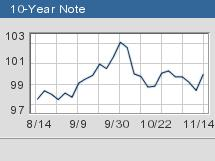NEW YORK (CNN/Money) -
Treasury prices continued to trade higher Friday, buoyed by greater confidence that an official interest rate hike is still some ways off regardless of mostly positive economic data.
Right before 4:00 p.m. ET, the benchmark 10-year note gained 19/32 of a point in price to 100-7/32, yielding 4.23 percent, down from 4.26 percent late Thursday. The 30-year bond jumped 24/32 of a point to 104-21/32, with a yield of 5.06 percent, down from 5.10 percent Thursday.

The two-year note edged 4/32 of a point higher to 99-20/32, yielding 1.82 percent, while the five-year note rose 14/32 of a point to 100-27/32 with a yield of 3.20 percent.
In the currency market, the dollar fell against the euro but strengthened against the Japanese yen. The euro bought $1.1778, up from $1.1730 late Thursday, and the dollar bought ¥108.33, up from ¥108.13 Thursday.
Bond prices have strengthened in the past week, to the surprise of many, shaking off the impact of the October jobs report and its signal of a resurgent employment market.
Philadelphia Fed President Anthony Santomero said Friday that low inflation and excess capacity will limit the Fed's need to raise interest rates for now.
"Any policy adjustment need not take place in the near future," Santomero told a bank forum.
His comments echoed those from St. Louis Fed President William Poole on Thursday, which helped trigger the current rally in Treasurys.
Bond dealers also took note of a Wall Street Journal story that said rates will remain low for many more months despite accelerating growth.
Confidence in a 25-basis-point Fed rate hike by the end of April -- as measured by Chicago Board of Trade fed funds futures -- has slipped to 42 percent from about 90 percent a week ago. Odds of a May rate hike are still at 92 percent, but as recently as Thursday reflected a sure bet.
Treasurys shook off a higher-than-expected gain in consumer confidence in the University of Michigan survey for November, as well as a sharp rise in the October producer price index.
Some analysts dismissed the PPI data as a one-month aberration driven by sharply rising food costs, and others focused on the frequent disconnect between consumers' mood and their buying patterns.
In that vein, Octoberretail sales were on the soft side, down 0.3 percent, or up 0.2 percent excluding autos. September sales were revised to down 0.4 percent from down 0.2 percent.
"Even the ex-auto part of the report has turned out distinctively unimpressive increases" in the past two months, said Anthony Karydakis, senior financial economist at Banc One Capital Markets.
U.S. equity prices had a lukewarm response to the day's data, helping to shore up Treasurys.

-- Reuters contributed to this report.
|

